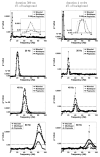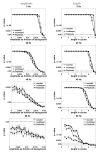Comparison of spectral analysis methods for characterizing brain oscillations
- PMID: 17292478
- PMCID: PMC2839452
- DOI: 10.1016/j.jneumeth.2006.12.004
Comparison of spectral analysis methods for characterizing brain oscillations
Abstract
Spectral analysis methods are now routinely used in electrophysiological studies of human and animal cognition. Although a wide variety of spectral methods has been used, the ways in which these methods differ are not generally understood. Here we use simulation methods to characterize the similarities and differences between three spectral analysis methods: wavelets, multitapers and P(episode). P(episode) is a novel method that quantifies the fraction of time that oscillations exceed amplitude and duration thresholds. We show that wavelets and P(episode) used side-by-side helps to disentangle length and amplitude of a signal. P(episode) is especially sensitive to fluctuations around its thresholds, puts frequencies on a more equal footing, and is sensitive to long but low-amplitude signals. In contrast, multitaper methods are less sensitive to weak signals, but are very frequency-specific. If frequency specificity is not essential, then wavelets and P(episode) are recommended.
Figures








References
-
- Bastiaansen M, Hagoort P. Event-induced theta responses as a window on the dynamics of memory. Cortex. 2003;39:967–992. - PubMed
-
- Berger H. Übert das Elektroenkephalogramm des menschen (On the human electroencephalogram) Archiv für Psychiatry und Nervenkrankheiten. 1929;87:527–570.
-
- Bronez TP. On the performance advantage of multitaper spectral analysis. IEEE Transactions on Signal Processing. 1992;40(12):2941–2946.
-
- Bruns A. Fourier-, Hilbert- and wavelet-based signal analysis: are they really different approaches? Journal of Neuroscience Methods. 2004;137:321–332. - PubMed
-
- Buzsáki G, Draguhn A. Neuronal oscillations in cortical networks. Science. 2004;304(5679):1926–1929. - PubMed
Publication types
MeSH terms
Grants and funding
LinkOut - more resources
Full Text Sources
Other Literature Sources

